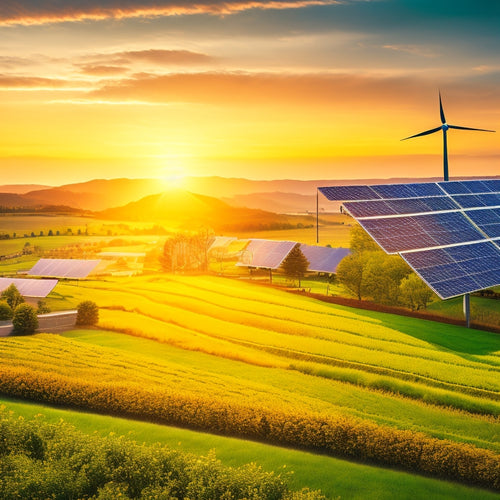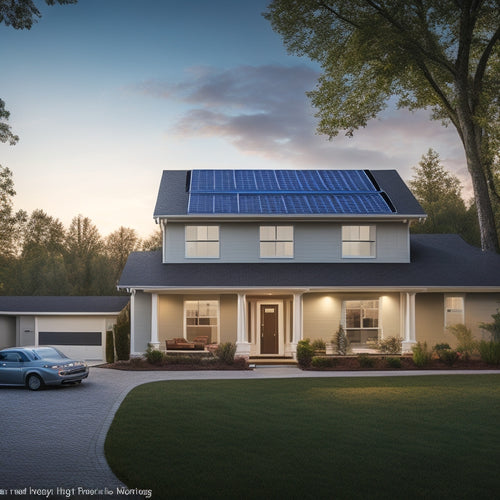
Cost Effective Solar Panels
Share
You're investing in cost-effective solar panels to reduce your energy bills and carbon footprint, as the average American family spends around $1,500 per year on electricity, with solar power offering a cleaner and more sustainable alternative. By shifting to solar energy, you'll minimize your climate change impact, lower your emissions, and increase your energy independence. Look for high-efficiency photovoltaic cells that enhance energy conversion and power output, and consider thinner silicon wafers that reduce material usage without sacrificing performance. By understanding your energy consumption rate and monitoring performance, you'll be well on your way to maximizing your solar panel's potential - and you're just getting started.
The Essentials
- Cost-effective solar panels reduce energy bills and environmental impact by utilizing abundant renewable energy sources like solar power.
- Thinner silicon wafers in solar panels reduce material costs without sacrificing performance, making solar energy more accessible and affordable.
- High-efficiency photovoltaic cells enhance energy conversion and power output, minimizing electricity bills through advancements in solar technology.
- Regular monitoring of solar panel systems ensures peak efficiency, identifies performance issues, and optimizes energy production and consumption.
- Investment in solar panels increases energy independence, reduces carbon footprint, and lowers energy bills, making it a cost-effective option in the long run.
Lower Carbon Footprint Promise
You're likely drawn to cost-effective solar panels because you want to reduce your reliance on fossil fuels and lower your carbon footprint.
By utilizing eco-friendly energy sources like solar power, you'll be producing clean energy that doesn't contribute to climate change.
With the installation of residential solar panels, you can unlock your home's solar power potential and reduce your emissions effectively.
As you reduce your emissions effectively, you'll not only be minimizing your environmental impact but also saving money on energy costs in the long run.
Eco-Friendly Energy Sources
As we shift our focus towards reducing our reliance on fossil fuels, exploring eco-friendly energy sources becomes an imperative step in mitigating climate change. You're likely aware that traditional energy sources are significant contributors to greenhouse gas emissions, but did you know that renewable resources can provide a cleaner alternative? By adopting sustainable practices and green technology, you can reduce your environmental impact and contribute to a cleaner, healthier planet.
Here's a breakdown of some eco-friendly energy sources:
| Energy Source | Benefits | Applications |
|---|---|---|
| Solar Energy | Zero emissions, abundant resource | Residential, commercial, industrial |
| Wind Energy | Low operating costs, reduced emissions | Commercial, industrial |
| Hydro Energy | High energy conversion rate, low emissions | Industrial, commercial |
These eco-friendly energy sources are not only beneficial for the environment, but they also promote energy conservation and can be more cost-effective in the long run. Additionally, solar innovations and energy policies are continually advancing, making it easier for you to access funding options and participate in community initiatives that support a cleaner, more sustainable future.
Reducing Emissions Effectively
Shifting to eco-friendly energy sources is an essential step in reducing emissions effectively, thereby keeping your carbon footprint in check. By adopting sustainable practices, you can markedly lower your reliance on fossil fuels and mitigate the environmental impact of your daily activities.
Emission reduction is a critical aspect of this process, as it directly affects the quality of our air, water, and land. With the help of renewable energy solutions like Solar Power Systems, you can make a notable impact on reducing your carbon footprint.
By utilizing the power of the sun, you can generate your own clean energy and reduce your reliance on grid electricity. As you change to solar power, you'll notice a substantial decrease in greenhouse gas emissions.
Solar panels capture clean energy from the sun, reducing your dependence on coal, oil, and natural gas. This, in turn, helps to minimize air pollution, protect biodiversity, and combat climate change.
Increased Energy Independence
When you invest in cost-effective solar panels, you're taking a significant step towards increased energy independence.
By incorporating renewable energy systems into your home, you'll not only reduce your carbon footprint but also lower your energy bills.
This means you'll have more local energy control, allowing you to manage your energy usage more effectively.
Local Energy Control
Most households spend a significant portion of their income on energy bills, and relying on the grid for power can be unpredictable and expensive. With local energy control, you can take charge of your energy management and reduce your reliance on the grid. This approach involves leveraging renewable resources, such as solar power, to generate energy locally.
| Benefits | Features |
|---|---|
| Increased Energy Independence | Community involvement in energy management |
| Reduced Energy Costs | Smart grids for efficient power distribution |
| Improved Energy Security | Local incentives for renewable energy adoption |
| Enhanced Energy Resilience | Grid integration for reliable power supply |
| Community Strengthening | Energy cooperatives for collective energy management |
Self-Sufficient Living
You can achieve increased energy independence by embracing self-sufficient living, where you're no longer at the mercy of the grid's whims.
By adopting off-grid living principles, you'll reduce your reliance on public utilities and utilize renewable resources like solar energy.
Implement sustainable gardening practices, incorporating permaculture principles to maximize yield while minimizing waste.
Opt for eco-friendly appliances and implement energy conservation measures to reduce your overall energy consumption.
Effective water management and composting techniques will further minimize your ecological footprint.
Consider alternative transportation options, such as electric or hybrid vehicles, to reduce your reliance on fossil fuels.
By reducing waste and adopting a self-sufficient lifestyle, you'll enjoy greater freedom and autonomy.
With cost-effective solar panels, you can generate your own clean energy and store excess power for later use.
High-Efficiency Photovoltaic Cells
You're likely familiar with the importance of efficient energy conversion in solar panels. High-efficiency photovoltaic cells can greatly improve cell efficiency, resulting in a substantial increase in power output.
In fact, the most efficient solar panels 2023 are designed to provide ideal power output and minimize electricity bills, thanks to advancements in Renewable energy systems.
Additionally, high-efficiency cells are often paired with microinverters to further enhance energy efficiency ratings. By optimizing these cells, you can generate more electricity per unit area, making your solar panel system more cost-effective.
Cell Efficiency Boost
As the solar industry continues to evolve, manufacturers have been working to increase the efficiency of photovoltaic cells, a crucial component in the pursuit of cost-effective solar panels.
You're likely aware that high-efficiency photovoltaic cells are key to maximizing cell performance and reducing costs. Recent technology advancements have led to significant improvements in manufacturing innovations, resulting in better material enhancements and lower production costs.
These advancements have trickled down to the market, driving trends towards more efficient and affordable solar panels. As you investigate the world of solar energy, you'll notice that installation techniques have also become more streamlined, allowing for faster and more efficient deployments.
Additionally, energy storage and grid integration have become critical components in ensuring a seamless shift to renewable energy. When evaluating solar panels, consider the longevity factors that impact their performance over time.
Power Output Increase
Enhancing power output is a vital aspect of cost-effective solar panels, and high-efficiency photovoltaic cells are at the forefront of this effort. You're likely aware that traditional solar panels convert around 15-20% of sunlight into electricity. However, high-efficiency photovoltaic cells have pushed this conversion rate up to 23-26%. This significant increase in power generation is essential for reducing the overall cost of solar technology.
| Efficiency Range | Power Output | Cost Savings |
|---|---|---|
| 15-20% | 300-400 W | 10-15% |
| 20-23% | 400-500 W | 20-25% |
| 23-26% | 500-600 W | 30-35% |
| 26-28% | 600-700 W | 40-45% |
| 28%+ | 700-800 W | 50-55% |
Check Wattage Per Hour
You need to take into account the peak power output of your solar panels, measured in watts (W), to determine how much electricity they can produce per hour. This is essential because it directly affects your energy consumption rate, which is the amount of electricity your appliances and devices use per hour.
With a residential solar power system that includes integrated battery backup, you can store excess energy generated during the day for use during the night or on cloudy days renewable energy systems.
Peak Power Output
Peak Power Output, the maximum amount of power your solar panel system can produce, is vital to understanding its overall performance. It's important to know how much power your system can generate at its peak to guarantee you're getting the most out of your investment.
| Factor | Impact on Peak Power Output |
|---|---|
| Peak Efficiency | Higher efficiency means more power output |
| Power Optimization | Optimizing power output reduces energy losses |
| Solar Technology | Advanced solar technology increases peak power output |
When designing your solar panel system, consider factors that affect peak power output, such as system design, installation costs, and maintenance requirements. A well-designed system with high peak power output can provide more energy storage and grid integration, leading to increased output reliability. Performance monitoring is also important to verify your system is operating at its best. By understanding peak power output, you can make informed decisions about your solar panel system and maximize your energy production, ultimately achieving energy freedom.
Energy Consumption Rate
Understanding your energy consumption rate is essential to determining the size of your solar panel system and ensuring it meets your energy needs.
You'll want to calculate your energy usage in watt-hours (Wh) per hour to get an accurate depiction. To do this, you'll need to check your appliances' wattage ratings and estimate how many hours you use them daily. For instance, if you have a 100W TV that you use for 5 hours a day, that's 500Wh or 0.5 kilowatt-hours (kWh).
Add up the total energy usage of all your appliances to get your daily energy consumption. This will help you determine the required capacity of your solar panel system. A higher energy consumption rate means you'll need a larger system to meet your energy needs.
Thinner Silicon Wafers Used
You'll notice that cost-effective solar panels often feature thinner silicon wafers, which have been reduced in thickness to minimize material usage.
This wafer thickness reduction leads to significant cost savings without compromising the panel's overall performance.
Wafer Thickness Reduction
Reducing wafer thickness has emerged as a crucial strategy in the quest for cost-effective solar panels. You're likely aware that traditional silicon wafers used in solar panels are relatively thick, which increases material costs. By reducing wafer thickness, manufacturers can greatly cut down on material usage, leading to substantial cost savings.
In wafer fabrication, thinner wafers require less silicon, which enhances material sustainability. This approach also enables you to produce more wafers from the same amount of material, increasing overall production efficiency.
Additionally, thinner wafers can lead to improved electrical performance, as they allow for better charge carrier mobility. This results in higher efficiency solar cells, which can generate more power per unit area.
As you investigate cost-effective solar panel options, consider the benefits of wafer thickness reduction. With the potential to lower production costs and enhance overall efficiency, this strategy is an important step towards making solar energy more accessible and affordable.
Frequently Asked Questions
How Long Does It Take to Install Solar Panels on an Average Home?
You'll typically spend 1-3 days on the installation process, depending on your home's size and complexity, with the actual installation timeline taking around 8-12 hours, including prep and setup, for an average residential installation.
Are Solar Panels More Prone to Damage in Extreme Weather?
You're wondering if solar panels can withstand extreme weather. The answer is yes, they're designed to be durable. Manufacturers test them to guarantee they can resist extreme weather impact, including hail, high winds, and heavy snowfall, so you can enjoy freedom from energy dependence.
Can I Install Solar Panels on a Rented Property?
As you pave your path to energy independence, you're likely wondering if you can install solar panels on a rented property. The answer lies in securing solar panel agreements and obtaining landlord permissions, ensuring a harmonious and sustainable coexistence.
Do Solar Panels Require Regular Maintenance or Cleaning?
You'll need to clean your solar panels periodically to guarantee maximum energy output, as dirt and debris can reduce efficiency; cleaning frequency depends on location and climate, but generally, a bi-annual cleaning maintains the 25-30 year solar panel lifespan.
Are There Any Government Incentives for Installing Solar Panels?
You'll be pleased to know that, yes, there are government incentives for installing solar panels; you're eligible for federal tax credits and state rebates, which can greatly offset the upfront cost, giving you more freedom to invest in renewable energy.
Final Thoughts
You've made the smart decision to invest in cost-effective solar panels, reducing your reliance on fossil fuels and shrinking your carbon footprint. With high-efficiency photovoltaic cells and thinner silicon wafers, you'll generate more power while spending less. Did you know that the average American home can save up to $500 annually on energy bills by switching to solar? By making the switch, you'll not only reduce your energy expenditure but also contribute to a cleaner, more sustainable future.
Related Posts
-

Net Metering in Renewable Energy's Future
Net metering's future is vital for driving renewable energy growth and financial savings. You can reduce your electri...
-

Building an Emergency Backup Solar Power System in 5 Essential Steps
Building an emergency backup solar power system involves five key steps. First, assess your daily energy needs to ide...
-

Cost of Solar With Battery Backup
You're investing in a solar panel system with battery backup to guarantee reliable power during outages. The cost of ...


